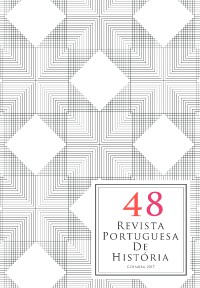Please use this identifier to cite or link to this item:
https://hdl.handle.net/10316.2/93622| DC Field | Value | Language |
|---|---|---|
| dc.contributor.author | Castro, Fátima Velez de | - |
| dc.date.accessioned | 2017-11-18T00:42:24Z | |
| dc.date.accessioned | 2020-10-05T00:48:32Z | - |
| dc.date.available | 2017-11-18T00:42:24Z | |
| dc.date.available | 2020-10-05T00:48:32Z | - |
| dc.date.issued | 2017 | - |
| dc.identifier.issn | 2183-3796 (digital) | - |
| dc.identifier.issn | 0870-4147 | - |
| dc.identifier.uri | https://hdl.handle.net/10316.2/43246 | - |
| dc.description.abstract | Neste artigo pretende‑se refletir sobre a relação entre o cinema e a história, considerando‑ se o filme como objeto de análise e instrumento de investigação, assim como construtor de ambientes históricos e de paisagens. Será por isso discutido o papel do cinema como produtor/reprodutor de momentos e de espaços, sendo invocadas e discutidas as posições de autores como Smith (1976), Ferro (1998), Kaes (1990), Morettin (2004), Protat (2009), Reigada (2013), entre outros. Tendo como base esta linha de ideias, assim como tomando em conta a dinâmica das migrações contemporâneas, será apresentado um estudo de caso que contribuirá para a compreensão dos sistemas migratórios transoceânicos do séc. XX. Para isso será realizada a análise de conteúdo do filme “The Immigrant” (1917), de Charlie Chaplin, tendo como foco a relação entre tempo, espaço e imagem fílmica. | por |
| dc.description.abstract | In this article it is intended to reflect on the relationship between cinema and history, considering the film as an object of analysis and an instrument of research, as well as a builder of historical environments and landscapes. Therefore, it will be discussed the cinema’s role as the producer/reproducer of moments and spaces, being cited and discussed the positions of authors such as Smith (1976), Ferro (1998), Kaes (1990), Moretti (2004), Protat (2009), Reigada (2013), amongst others. Based on this line of ideas, as well as taking into account the dynamics of contemporary migrations, it will be presented a case study which will contribute towards the understanding of transoceanic migration systems in the 20th century. In order to do that, it will be conducted a content analysis of the movie “The Immigrant” (1917), by Charles Chaplin, being focused the relation between time, space and movie image. | eng |
| dc.language.iso | por | - |
| dc.publisher | Imprensa da Universidade de Coimbra | - |
| dc.rights | open access | - |
| dc.subject | cinema | eng |
| dc.subject | history | eng |
| dc.subject | migration | eng |
| dc.subject | Charlie Chaplin | eng |
| dc.subject | cinema | por |
| dc.subject | história | por |
| dc.subject | migrações | por |
| dc.subject | Charlie Chaplin | por |
| dc.title | O cinema e a História: compreensão da dinâmica cronotópica das migrações contemporâneas a partir do filme “The Immigrant”, de Charlie Chaplin (1917) | por |
| dc.title.alternative | Cinema and History: understanding the chronotopic dynamics of contemporary migrations from Charlie Chaplin’s The Immigrant (1917) | por |
| dc.type | article | - |
| uc.publication.collection | Revista Portuguesa de História nº 48 | - |
| uc.publication.firstPage | 227 | - |
| uc.publication.issue | 48 | - |
| uc.publication.lastPage | 239 | - |
| uc.publication.location | Coimbra | - |
| uc.publication.journalTitle | Revista Portuguesa de História | - |
| dc.identifier.doi | 10.14195/0870-4147_48_10 | - |
| uc.publication.section | Dossier temático "Mobilidade e migrações" | - |
| uc.publication.orderno | 12 | - |
| uc.publication.area | Artes e Humanidades | - |
| uc.publication.manifest | https://dl.uc.pt/json/iiif/10316.2/93622/269531/manifest?manifest=/json/iiif/10316.2/93622/269531/manifest | - |
| uc.publication.thumbnail | https://dl.uc.pt/retrieve/12153522 | - |
| item.grantfulltext | open | - |
| item.fulltext | With Fulltext | - |
| Appears in Collections: | Revista Portuguesa de História | |
Files in This Item:
| File | Description | Size | Format | |
|---|---|---|---|---|
| o_cinema_e_a_historia.pdf | 518.76 kB | Adobe PDF |  |
Items in DSpace are protected by copyright, with all rights reserved, unless otherwise indicated.
